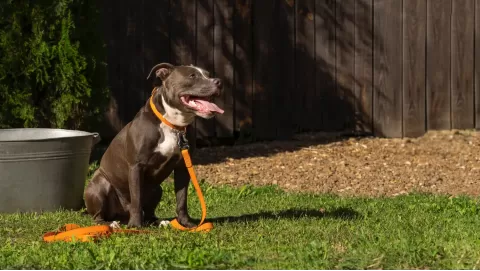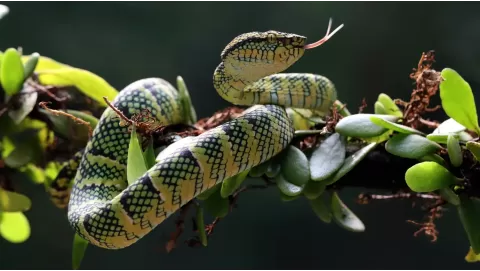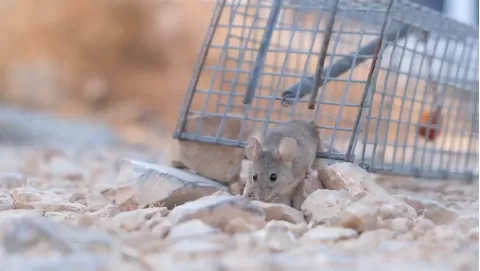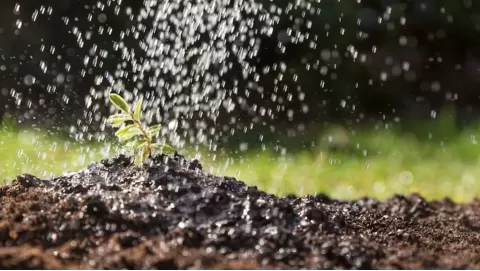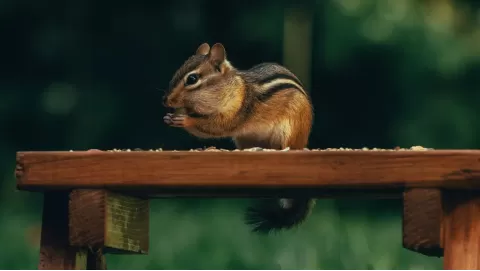
Best deer repellents for gardens and landscapes: Keep deer away naturally
Many people see the plants with missing leaves, eaten flowers or broken stems. The deer will consume all sorts of plants, such as fruits, vegetables, bushes, and sometimes tree bark. In some cases, the damage is so severe that the plants don’t recover. In some areas, deer do significant damage each year.
This is where natural deer repellent for gardens comes in handy. These repellents keep deer away without harming them. They safeguard plants while saving gardeners time, energy, and money. With the proper repellent tactics, enjoy a healthy garden year-round.
Growcycle is a trusted source for natural garden care and effective deer control for landscaping. For plant and landscape protection from deer, they specialize in an all-natural, safe range of deer repellent solutions.
Understanding Deer Behavior and Preferences
Deer alter their dietary habits according to the season. In the spring and summer, they feed primarily on tender greens, flowers, fruits and vegetables. In autumn, they transition to nuts, berries and shrubs. In winter, when food is scarce, they consume bark, twigs and anything else that’s still green.
An adult deer, on average, eats up to 10 pounds of plants per night. That makes them a fairly serious problem, especially if they show up night after night. They tend to be most active in the early morning and late evening and often quietly forage across yards and landscapes.
Deer tend to take familiar routes. They typically show up from nearby woods, parks or open fields. If a garden is situated nearby, then there’s a good chance it will be attractive to deer, particularly if the plants suit their taste.
Some plants are more attractive to deer than others. They often prefer:
- Roses
- Tulips
- Hostas
- Beans and peas
- Lettuce and spinach
- Fruit trees and berries
Deer become less choosy when natural food is limited. They’ll eat just about any plants they encounter, many that are normally avoided. That’s why gardens are still susceptible in late fall or winter.
Plant-Based Deterrents and Landscape Choices
Plantings that deter a deer are naturally resistant. These can be used to create borders around flower beds, vegetable patches, or walkways. These natural borders serve as a kind of soft fence; deer would rather not step through plants they don’t like.
Some commonly recognized deer resistant plants include:
- Deer do not like the strong scent of lavender.
- The flowers of marigolds have a bitter flavor.
- Rosemary is a woody plant with a pungent aroma.
- Yarrow leaves that deer reject avoid.
- Catmint is easy to grow and has a scent that deer disdain.
- Boxwood is a tough shrub with thick, unlovely leaves.
- The daffodil is toxic to deer and many other animals.
Besides acting as protective measures, these plants are also beautiful and attract beneficial insects such as bees and butterflies.
Smart Garden Design
The design of a garden also matters. Here are two common layout styles to help keep plants protected:
- Perimeter Planting: Deer-resistant plants are positioned in the exterior edges of the garden. It provides a natural barrier and conceals the scent of plants that deer prefer.
- Mixed Planting: Plants that deer will and will not eat are mixed together rather than segregated. This confuses deer and makes it more difficult for them to locate food that they want to eat.
Some gardeners leave open grounds and prevent thick bushes from growing close to railings or edges. Deer prefer security and concealment, and they will avoid gardens that feel exposed.
Homemade Natural Repellents
Homemade deer repellents are an excellent solution if people want to use inexpensive and natural solutions. Most of these repellents can be made with items one already has in the kitchen or bathroom. They do not hurt the deer, and they are effective at protecting gardens fast in a non-violent, eco-friendly way.
1. Soap Bars
Strong-smelling soap like Irish Spring can be cut into small pieces and hung around the garden with string or mesh bags. It’s useful to repel deer because of its strong scent. Stick soap bars on the stick that is adjacent to the plants.
2. Egg-and-Milk Mixture
By combining eggs, milk and water, a smell is created that deer dislike. A common recipe is:
- 1 egg
- 1 cup of milk
- 2 cups of water
Combine the ingredients thoroughly, and then spray the mixture onto plants. Apply this spray as early in the morning or late in the day so as not to burn the leaves with the sun.
3. Essential Oil Sprays
Mix strong oils of peppermint, citrus and those made of garlic with water and use as a natural spray. A basic recipe is:
- 10–15 drops of essential oil.
- 1 tablespoon of dish soap (helps the spray stick to leaves).
- 1 quart of water.
Use this as a spray on plants and garden borders. The smell masks the scent of plants favored by deer.
How Often to Reapply
Choose a homemade deer spray that works well, but they don’t last forever. Rain, wind, and watering can wash them off. That’s why it’s important to reapply them regularly.
- Egg-based sprays: Reapply every two weeks, or more often if it rains.
- Essential oil sprays: Longer lasting, typically 4 to 6 weeks, but check after heavy rain.
- Soap bars: Can last for weeks, but may need to be replaced if the smell fades or after a long rain.
Gardeners are advised to check their plants frequently and renew the repellents as required for optimal effectiveness. Mixing various DIY repellents can even offer more potent protection.
Commercial Natural Sprays and Granular Products
Commercial natural sprays and granular products, which are already mixed up and ready to use, are also perfect for those who prefer ready-made products. These humane deer repellents help keep the critters away from gardens and landscapes without doing any harm to the surrounding environment.
1. IMG® All Season Deer Repellent
One of the best deer repellent for flowers is a spray made from all-natural botanical oils (like peppermint, lemongrass, cinnamon, and clove) mixed with eggs and garlic to create a smell that deer hate. It’s biodegradable, non-toxic and safe for children and pets, so it’s perfect for home gardens.
Each bottle covers up to 1,000 square feet. For larger spaces, Growcycle provides a hose-end version that can cover up to 10,000 square feet.
2. DEER STOPPER II® Animal Repellent
Made from a little blend of cinnamon and clove with putrescent egg solids, this plant-based formula is an extremely powerful sensory deterrent. The smell and taste of the plants are unpleasant for deer, which aid on how to keep deer out of yard.
The formula is odorless when dry, offering up to 30 days of protection per application. Safe on fruits, vegetables, and ornamental plants, it’s an ideal option for any garden.
3. Bobbex™ Deer Repellent Concentrate
The Bobbex Deer Repellent is a smell and taste deterrent that works in two ways. The wintergreen-based formula can last up to two months, even in rain or snow.
It works great on white-tailed, black-tailed, mule deer, elk, and moose. This one is ideal for larger gardens or regions with drastically changing weather.
4. Safer® Deer & Rabbit Repellent
If users want a multi-purpose repellent product, choose Safer®, which is a great product. It uses both scent and taste deterrents to repel deer, rabbits and squirrels.
Long-lasting, organic solution for small gardens or areas with less deer pressure, covers up to 500 square feet, and protects up to 3 months.
5. EPIC® Deer Scram™ Granular Repellent
EPIC Deer Scram employs a proprietary predator odor blend that triggers a powerful fear response because deer associate it with dead family members. This granular repellent comes in a 6 lb bag and treats up to 5,400 square feet, making it a great option for larger spaces.
It is biodegradable, non-toxic, and works well in all weather conditions, even snow. For very large spaces, Deer Scram is also available in a 25 lb pail, which will cover up to 32,400 square feet and offer 30-45 days of protection per application.
Physical Barriers and Mechanical Devices
For gardeners seeking reliable ways to keep deer away from their plants, physical barriers and mechanical devices provide a strong line of defense. These methods can be especially effective when used in combination with natural repellents.
Fencing Options
Installing proper fencing is one of the best methods for keeping deer out of the garden. Because deer are strong and determined, the fence must be tall, substantial, and specifically intended to keep deer out.
1. 8-Foot Welded Wire Fencing
The best and most dependable way to keep deer out is with an 8-foot welded wire fence. This distance is critical, as deer can clear lower barriers. The welded wire is well built, long lasting, and hard for deer to chew through. It is an almost impermeable barrier. Deer are not likely to try to clear a fence this tall, and they can’t navigate it very easily.
- Bury the bottom of the fence 6-12 inches into the ground to stop deer from digging under.
- If installing the fence in a straight line or with a slight outward angle, its deterrent effect may increase.
- Cover with a layer of repellent spray for added protection on the fence.
2. Dual 4-Foot Fences (Double Fence Method)
A second effective method is to place two 4-foot fences at least 3 to 4 feet apart. This results in a “psychological barrier” that confuses deer and makes it uncomfortable for them to jump over or try to go through.
The two fences leave deer feeling unsure. When they try to jump, the height of the gap they must traverse leaves them confounded, which often keeps them from attempting it altogether.
- Make sure that the two fences are strong enough and high enough that the deer will see them as a serious barrier.
- Install a simple post-and-wire system, or, if folks prefer, a mesh fence to serve as both barriers.
- This is most effective in areas known for deer frequenting the garden.
Motion-Activated Deterrents
Beyond fencing, motion-activated devices represent a more active way to discourage deer. These devices activate when deer or other animals approach and use sudden motions or sounds to frighten the animals and coax them away.
1. Motion-Activated Sprinklers
Motion-activated sprinklers work extremely well to deter deer. These appliances sense motion within a designated range and dispense a spray of water instantly. The deer is startled by the sudden spray and runs away.
Set up sprinklers near common entry points, such as gates, paths or places where deer frequent. Keep the area around the sprinkler clear of obstructions so the sensor can easily detect motion.
2. Motion-Activated Lights
The deer are genetically programmed to be suspicious of changes in lighting. Twinkling lights that operate by motion may confuse and frighten deer by illuminating bright lights when activity is sensed.
Put these lights along the perimeter of the garden or along walkways where deer come in. Because this is done to scare the deer without spooking the whole area, the lights should be placed to frighten them.
3. Ultrasonic Devices
Ultrasonic devices produce a high-pitched sound that is inaudible to humans but very unpleasant to deer. The sounds induce discomfort and a flight response in the animals, and discourage them from approaching the area.
These devices should be placed near the edge of your garden or along deer pathways to ensure they hear the sound as they approach. Ideally, they should be placed in open areas where they can broadcast their signal over a wide range.
Scent- and Taste-Based Techniques
Scent- and taste-based deterrents rely on deer’s natural instincts and aversions to particular odors and tastes. These scents work by either pretending to be predator urine or giving deer an unpleasant taste that they dislike.
1. Predator Urine
One of the most powerful and commonly used off-the-shelf natural repellents is predator urine. Deer naturally steer clear of regions where they detect the presence of predators, be it coyotes, wolves or mountain lions. Gardeners can take advantage of this natural fear response by utilizing predator urine.
Deer view an area as dangerous when they detect the smell of predator pee. Deer appear to avoid areas that smell of these odors since they instinctively avoid the territory of predators.
The urine of a predator, which can be bought in liquid form at garden centers and online retailers, is also an option, but it has to be soaked in pads. It’s simple to use, by scattering the liquid around the edges of the garden or placing the pads near deer entry points. Besides, the aroma can be pretty strong, so make sure you put it far away from where people or pets will walk by.
2. Ammonia-Soaked Rags
Ammonia is a scent that deer find overwhelming and unpleasant. Hanging ammonia-soaked rags or cloths around the garden will leave a strong smell that will repel deer.
The potent odor of ammonia burns the sensitive membranes in the deer’s nose. The smell signals danger or an unpleasant living situation to deer, meaning they leave the area.
Soak rags or old cloths in ammonia, and hang them on trees, fences, or another structure on the garden’s perimeter. Just make sure to lay them out in such a way that the ammoniac smell is distributed over a wide area.
3. Hanging Soap Bars (e.g., Irish Spring)
One other method that has popularity and is widely followed is hanging bars of soap, especially Irish Spring soap, near the garden. Certain soap's odour is strongly distasteful to deer, so they stay away.
The strong smell of Irish Spring soap overwhelms the deer’s sense of smell, causing them to stay away from the area. Not as pungent as predator urine or ammonia, however, soap is a long-lasting, low-maintenance deer deterrent safe for pets.
Use mesh bags to hang bars of soap, or just hang bars of soap directly on a tree branch, a fence post or a garden stake. Hang the soap at different heights in the garden so that the scented oils waft through different nooks of the area.
FAQs
What is the most effective natural deer repellent for gardens?
The most effective natural repellents are predator urine (like coyote or wolf urine). It makes deer afraid and keeps them away.
What smells do deer hate the most?
Deer tend to be repelled by potent scents like garlic, peppermint, citrus, ammonia and soap (think Irish Spring).
How to keep deer out of yard in an easy way?
Hanging bars of smelly soap like Irish Spring or using homemade deer spray, with eggs and garlic, are inexpensive, effective methods.
The Bottom Line
One of the biggest problems in gardens is the deer, and the right steps can keep them out. Natural repellents, planting deer-resistant plants and building barriers are some ways to safeguard gardens. Gardeners have options from homemade, effective deer spray to scent-based tricks to bought products by a reliable marketplace such as Growcycle. Fences and motion-activated devices are also effective, particularly in areas where deer are prevalent.
Disclaimer: This material is for informational purposes only and should not be relied on for legal, medical, financial, or any other form of professional advice.




